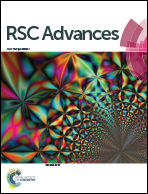Tailor-made poly(l-lactide)/poly(lactide-co-glycolide)/hydroxyapatite composite scaffolds prepared via high-pressure compression molding/salt leaching†
Abstract
A significant challenge in bone tissue engineering is the development of biomimetic scaffolds that can meet the requirements of mechanical and degradation properties at the same time. The composite scaffolds comprising poly(L-lactide) (PLLA), poly(lactide-co-glycolide) (PLGA) and hydroxyapatite (HA) were fabricated by a new method, i.e., high-pressure compression molding plus salt-leaching technique. The scaffolds obtained show an encouraging improvement in the mechanical performance. The compressive modulus reaches up to 4.64 ± 0.2 MPa, comparable to human cancellous bone (2–10 MPa), offering the possibility to develop load-bearing scaffolds. Furthermore, by adjusting the weight ratio of PLLA to PLGA, the degradation rate, hydrophilicity, and mechanical properties of scaffolds can be fine-tuned. The overall characteristics of porous composite scaffolds are definitely optimal when the mass ratio of PLLA/PLGA is 5 : 5. Its porosity, contact angle, compressive modulus and weight loss at the 12th week are 81.7%, 53.13°, 4.64 ± 0.2 MPa and 67.21 ± 3.14%, respectively, satisfying the physiological demands to guide tissue regeneration. Scaffolds with the best comprehensive properties are further utilized for in vitro tests. As presented from the excellent spreading and the high proliferation rate of cells, the design of such tailor-made scaffolds as a function of composition is a convenient strategy to address the specific requirements of the tissue to be regenerated.



 Please wait while we load your content...
Please wait while we load your content...